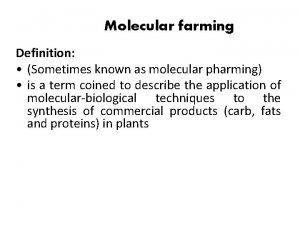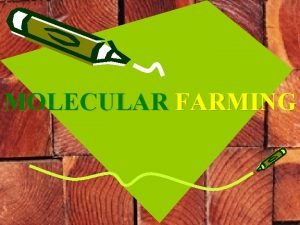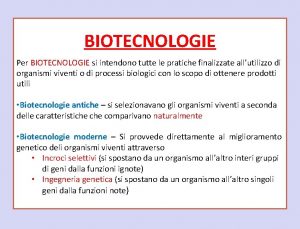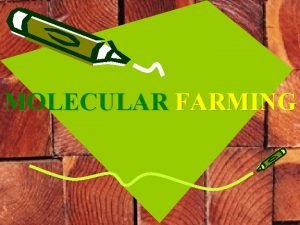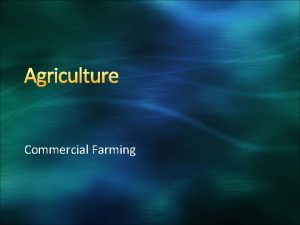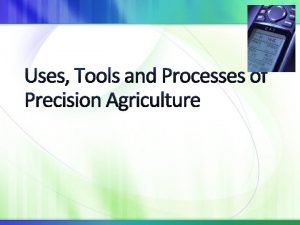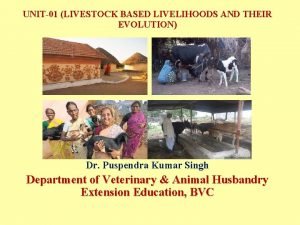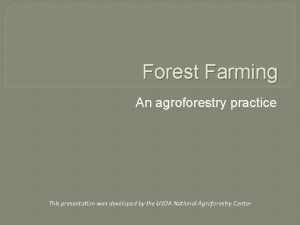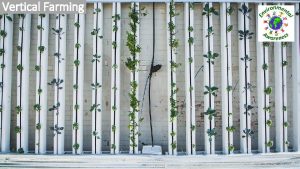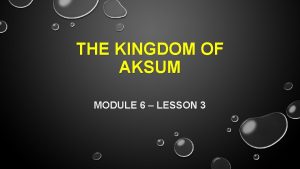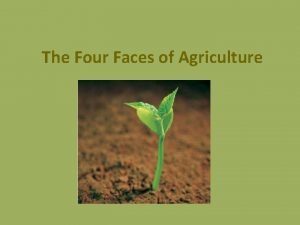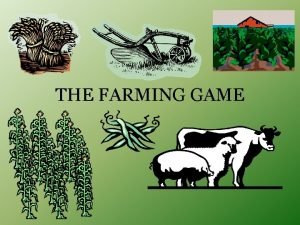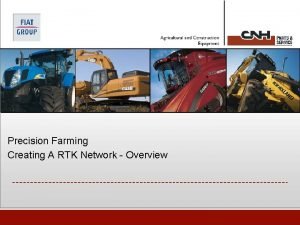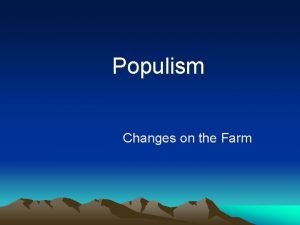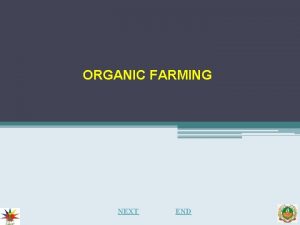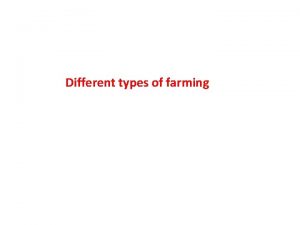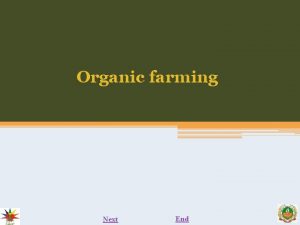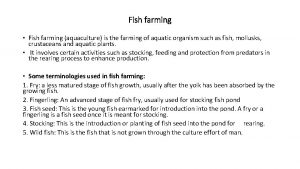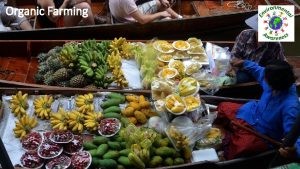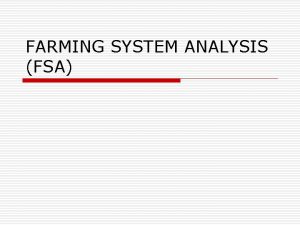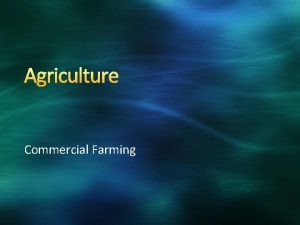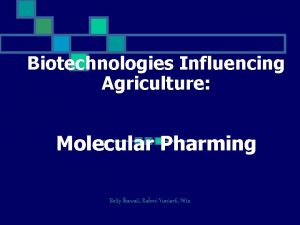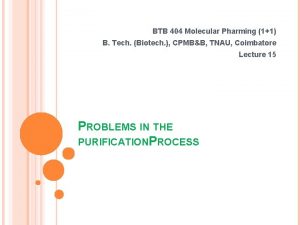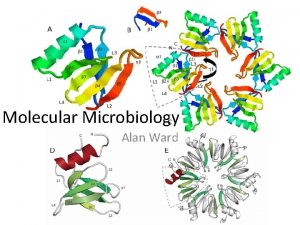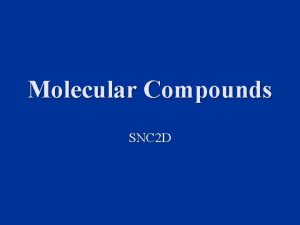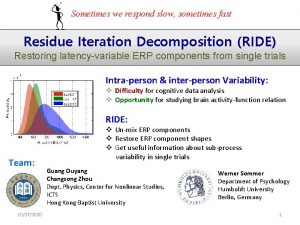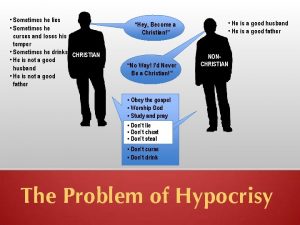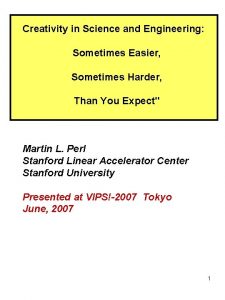Molecular farming Definition Sometimes known as molecular pharming


































- Slides: 34

Molecular farming Definition: • (Sometimes known as molecular pharming) • is a term coined to describe the application of molecular-biological techniques to the synthesis of commercial products (carb, fats and proteins) in plants

Carbohydrate • Plants produce a range of valuable carbohydrates • Cellulose used for textile fibers, paper making, in paints and polymer • Starch used for food, feed and industrial purposes • Molecular farming improving the yield and quality of these

Carbohydrate production • Carbohydrate are synthesized and stored in a variety of cellular compartments e. g. starch and its derivatives are synthesized in plastids, fructans in vacuole, sugars and sugar alcohols in cytosol

Starch

Starch • Pathway for biosynthesis: triose phosphate converted to hexose phosphate and then ADPglucose which act as precursor substrate, catalyzed by ADP-glucose pyrophosphorylase. • The production of ADP-glucose could be altered in molecular farming by the regulation of ADP-glucose pyrophosphorylase which in return regulate the enhanced formation of starch

. Cyclodextrins • “Rings of six, seven or eight glucose residues” • One type of high value product that could be made from starch is the cyclodextrins • These compounds are normally produced by bacterial fermentation of maize starch, particularly for pharmaceuticals applications • Useful for solubilization of hydrophobic (water-fearing) pharmaceuticals such as steroids so at lower concentration like injection into the blood stream therapeutics agent is released

Cyclodextrins Cont. • This makes it as a suitable target for molecular farming • A bacterial cyclodextrin gene from Klebsiella pneumoniae and placed under control of promoter • The promoter directs the high level of expression in tubers of transgenic potato

Trehalose • Is a carbohydrates, a disaccharide formed by α-glucose units. • Trehalose is produced in some plants and microorganisms (e. g. yeast) in response to osmotic stress that create water deficient • This makes it as a suitable target for molecular farming it is also valuable for food processing and flavor retention • Genes for Trehalose synthesis from yeast and E. coli have been introduced into tobacco, potato and rice to increase drought tolerance

Lipids • In daily life our closest association with plants oil as cooking oils. Plant oils have an increasing no. of applications in industry for the manufacturing of soaps & detergents, lubricants and biofuel. • Non food applications comprise only 10% of total veg. oil produced. Reason for this relatively low level of industrial use is the complex and variable nature of plant oils.

Lipids Cont. . • Molecular farming therefore have role to 1. Improvement of existing lipid products 2. Engineering of novel lipid products Fatty acid are a key component of lipids Fatty acids: are the carbon chains with the methyl groups at one end of the molecule and carboxyl at other end • Saturated fats: contain no double bonds • Unsaturated fats: contain double bonds

Improvement of plant oils • Oilseed rape, canola and soybean- major source of oil and are often unspecified • Sunflower, corn and olive oil-particular purposes • Uses in- processed food, animal feeds, soaps, detergents, lubricants and biofuel • Major goal is improvement of plant oil for industrial applications-replace nonrenewable, petroleum based products. • Plants store oil as triacylglycerols

Fatty acid biosynthesis Pathway for biosynthesis: Acetyl coenzyme A(Co. A) • Elongated fatty acid transferred to another ACP protein and then condensed to new Malonyl –ACP. • Stepwise addition of two carbon units to form new fatty acid. • Desaturase enzyme responsible for double-Bond formation • Thioesterease enzyme causes hydrolysis of Acyl-ACP

Production of shorter-chain fatty acids • the oil produced by major oil crops is C 16 and C 18 in length while the coconut and palm kernel oils are C 8 -C 14 and lauric acid C 12 is imp raw material for prod of soaps, cosmetics and detergents. • the synthesis of fatty acids at a particular length is terminated by the hydrolysis of the acyl-ACP by Thioesterease. • California bay tree contain high proportion of lauric acids in seeds and an acyl-ACP thioesterase that specifically hydrolyses lauroyl-ACP has been cloned from this source.

• the intro of this gene into oilseed rape causes fatty acid synthesis to terminate at the C: 12 stage and high proportion of lauric acid Production of longer chain fatty acids Erucic acid is valuable industrial oleochemical. In oilseed rape and brassica specie; two-step elongation pathway from oleoyl-Co. A to eucoyl-Co. A. Identity preservation systems are required to keep HEAR and LEAR separate. modification of degree of saturation • first attempts in this area was to decrease the desaturase enzyme because the desaturase enzyme is responsible for the oleic acid production (double-bond), so the level of stearic acid (single-bond) increased at the expense of oleic acid

• by inserting an antisense construct of desaturase gene into oilseed rape. the antisense gene was under control of promoter (brassicas) • There is marked decrease in enzyme resulting in decrease formation of oleic acid.

Molecular farming of proteins we studied that transgene expression is used as a tool of molecular farming but in some cases it is the transgenic protein itself that is important we will consider the: a)Enzymes for industrial and agricultural uses b)Antibodies: full and engineered c)Subunit Vaccines: based on short peptide sequences-act as antigens d)Protein antibiotics Production systems the interest in producing such proteins comes in part from the problems associated with existing fermentation or bioreactor systems.

• Mammalian cell systems: are expensive and cannot easily be scaled up • Bacterial and yeast systems: can be scaled up to some extent but in case of prokaryotes, the recombinant proteins are often not processed properly, so intracellular precipitation of proteins can occur. • Plant systems: can be scaled up so that large amounts of material can be harvested and processed, allowing the industrial-scale amounts of proteins to be purified.

Strategies for protein production: a. stable integration approach b. use of plant viruses as vectors Stable expression of the transgene in the nucleus The major advantage of this approach is the inheritability of the transgene. Once a line has been selected that has optimal expression level, it can be used to produce the protein over a number of growing season. • Disadvantages: it takes long time to produce the lines and less than good expression levels

• Stable expression of transgene using constitutive promoter: approach in which the transgene is regulated by strong, constitutive promoter (such as 35 S promoter), is most suitable for the bulk production of soluble proteins in leaves, although yields can be low using this approach • Stable expression of transgene using Tissue-specific promoter: more sophisticated approach restricting gene expression to particular organs or tissues often leads to higher yields of recombinant protein

Different routes of protein manufacture in stably transformed plants

Virus expression system: transient and stable systems Plant viruses have been used as vector systems for the production of recombinant proteins. The main ones used have included tobacco mosaic virus (TMV), potato virus X (PVS), and alfalfa mosiac virus (AIMV). • There are several advantages to using viruses which include short production time scale, scale-up capacity, and very high production levels • Initial work in this area did not involve producing transgenic plants. Rather plant virus capsids were used as carriers of recombinant proteins, particularly vaccines. • In another approach, viral vectors to produce recombinant proteins are used. The virus can be replicated in host plant, through serial passage enough protein can be generated for clinical use.

Construction of recombinant plant virus carrying a protein epitope

• Limiting factor on time for the process is identifying the epitope and vector construction. Virus replicate and moves through the plant as in normal infection-2 to 3 weeks. • Yields reflect normal level of protein production and can be as high as 10% of total soluble proteins- which has been achieved by using recombinant and molecular evolution techniques to optimize viral replication and movement in plants.

• Alternative strategies involved introducing movement proteins into the plants- in this area the goal is to create a better host, one that allows virus replication to occur optimally. • Other strategy- to improve protein production systems using viruses. • One is deconstructed virus approach, another is to use stable integration of virus sequence in plants and induce its expression in a controlled manner- this could be either the synthesis of virus RNA or switching on the expression of gene of interest.

Production of Enzymes for industrial usage • First commercialized industrial protein producedavidin (from chicken) and Beta-glucuronidase (GUS, from E. coli)-both were produced in maize. • Prodigene-large scale production of trypsinproteolytic enzyme • Cellulases and xylanases-normally produced by microorganisms-been produced in plants. • Manganese peroxidase (from white rot fungus) in maize. • Transgenic plants have been produced expressing Phytase in seeds.

Medically related proteins Medicine is an important, expanding area for plant biotechnology • Antibodies or ‘Plantibodies’ • Vaccines • Other medically related proteins

Antibodies or ‘Plantibodies’ • Five major classes- Ig. A, Ig. D, Ig. E, Ig. G and Ig. M. • Each class has its own class of heavy chain and two light chains- each antibody has two antigen binding sites. • Functional antibody produced in plant in 1989. • Targeting of antibody chains to lumen of ER was found to be necessary for chain stability and assembly.

• Another important observation-formation of complete antibody in F 1 plants increased protein yield, reflecting the stable nature of complete antibody in plant system. • Plants are capable of synthesizing complex transgenic protein molecules such as the secretory antibody s. Ig. A. • Antibodies produced in plants are thought to be suitable for topical immunotherapy. • Single plant cells containing all four transgenes are able to produce them efficiently.

• s. Ig. A are resistant to proteolysis and bind antigen with higher efficiency. • Plants have been used to produce-whoe antibodies, antigen-binding fragments and sc. Fvs. • One particular focus has been on Glycosylation and many approaches have been tried to increase level of protein accumulation.

Plant Derived Vaccines • Both stable and transient expression systems have been used to produce vaccines in plants. • First successful attempts-transient expression system. • Recombinant CPMV was used as vector for linear epitope from VP 2 capsid protein of mink enteritis virus (MEV). • Vaccine was able to induce resistance to clinical infection by MEV.

• Vaccine to swine fever has been produced in plants using fusion of E 2 glycoprotein fused to CP of PVX. • Aim of such studies-generation of edible vaccines. • Plant based system-potential to provide low cost, easily administered, locally produced edible vaccine that could provide mucosal immunity. • One area of interest is use of fusion proteins. • Protein fusions may stabilize transgenic proteins and increase accumulation.

• Recently, the human immunodeficiency virus type 1(HIV-1) p 24 capsid protein fused with an Ig. A (immunoglobulins) has been expressed in tobacco where it was targeted to the endomembrabe system. These developments increased the production level 13 -fold. • Bananas are considered to be ideal production system-as grown widely and can be eaten raw.

Other medically related proteins; biopharmaceuticals • Although recombinant proteins have been produced-one problem associated is that these often give relatively low product yield and recovery. • Various strategies to overcome this problem-use of novel purification systems and choloroplast transformation. • Trichosanthin- component of tuber plant used in chinese medicine. Useful as treatment of HIV/AIDS.

• Glucocerebrosidase- Gaucher’s disease is an inherited disorder in which glucocerebroside accumulate in lysosomes, due to enzyme deficiency. Process to produce glucocerebrosidase in tobacco has been done recently. • Human-Serum Albumin- potential medical applications like treatment of burns and in liver cirrhosis. HAS has been expressed in tobacco and potato under the control of 35 S promoter. • Arginine vasopressin.
 Molecular farming
Molecular farming Molecular farming definition
Molecular farming definition Pharming ict
Pharming ict Pharming biologia
Pharming biologia Why is pharming controversial
Why is pharming controversial Ethical issues of genetic engineering
Ethical issues of genetic engineering They say sometimes you win some
They say sometimes you win some Sometimes you win some sometimes you lose some
Sometimes you win some sometimes you lose some Sometimes sweet
Sometimes sweet Sometimes cold sometimes hot
Sometimes cold sometimes hot Types of molecular farming
Types of molecular farming Giant molecular structure vs simple molecular structure
Giant molecular structure vs simple molecular structure Giant molecular structure vs simple molecular structure
Giant molecular structure vs simple molecular structure Zinc oxide + nitric acid → zinc nitrate + water
Zinc oxide + nitric acid → zinc nitrate + water Sharecropping
Sharecropping Homa farming definition
Homa farming definition Homa farming
Homa farming Custom farming definition
Custom farming definition Intensive subsistence farming definition
Intensive subsistence farming definition Truck farming ap human geography
Truck farming ap human geography Terraced farming definition geography
Terraced farming definition geography Highest peak in the world
Highest peak in the world Commercial ranching definition
Commercial ranching definition Define precision farming
Define precision farming Farming system definition
Farming system definition Forest farming definition
Forest farming definition Terrace farming definition ap human geography
Terrace farming definition ap human geography Aimwhere
Aimwhere Vertical farming pros and cons
Vertical farming pros and cons Who created
Who created Pros and cons of organic farming
Pros and cons of organic farming The farming game rules
The farming game rules Fishing and mining
Fishing and mining Rtk gps farming
Rtk gps farming Why had farming become unprofitable during this period?
Why had farming become unprofitable during this period?
